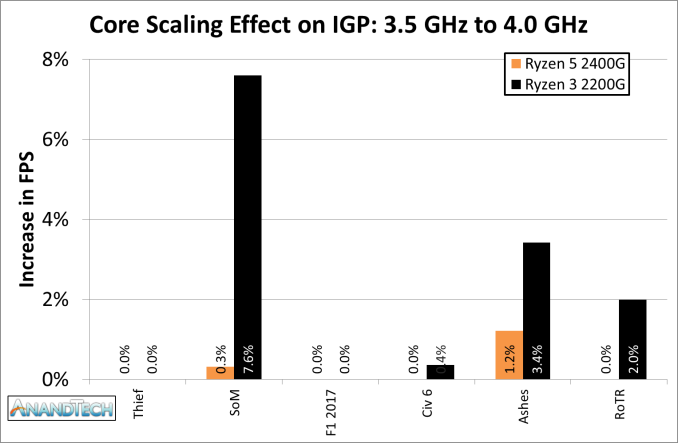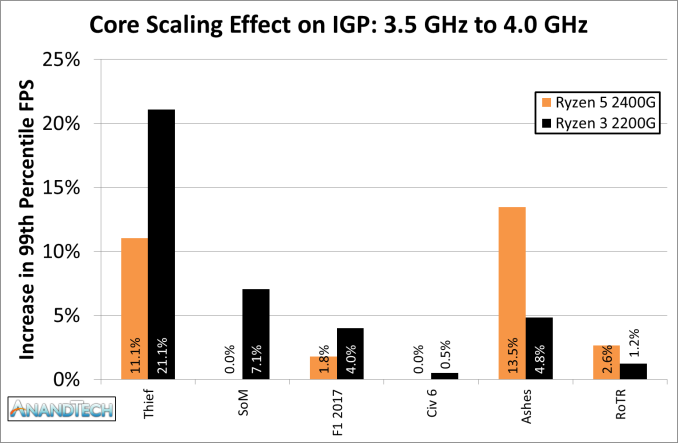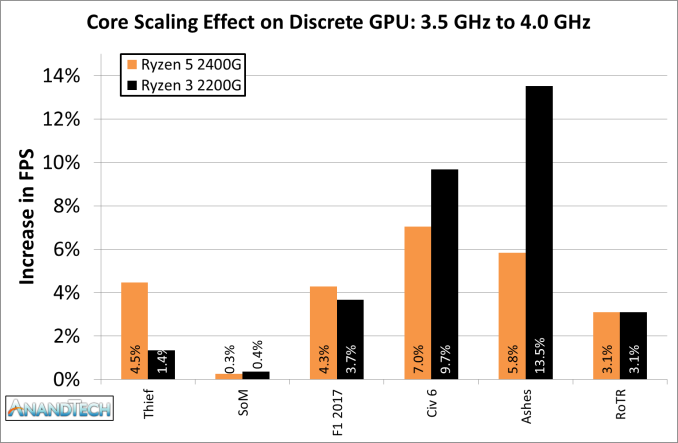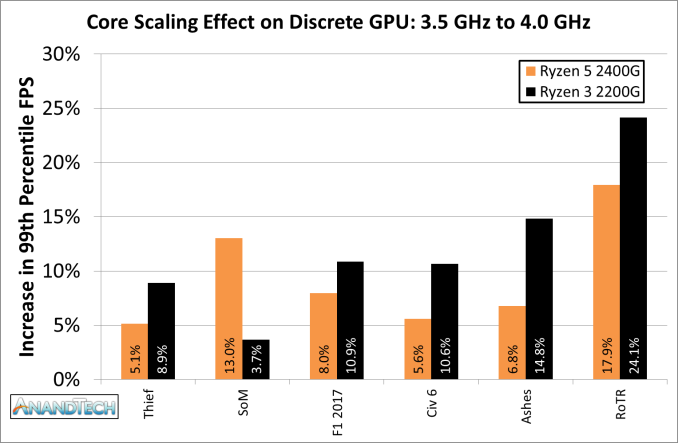AMD Ryzen 5 2400G and Ryzen 3 2200G Core Frequency Scaling: An Analysis
by Gavin Bonshor on June 20, 2018 10:05 AM EST- Posted in
- CPUs
- AMD
- Zen
- APU
- Vega
- Ryzen
- Ryzen 5
- Ryzen 3
- Scaling
- CPU Frequency
- Ryzen 3 2200G
- Ryzen 5 2400G
APU Core Frequency Scaling
One of the holy grails in processor performance is higher clock speed. All things being told, if we exclude power consumption from the mix, most performance tools will prefer, in order, a high IPC, then a high frequency, and finally more cores. Building a magical processor with double the IPC or double the frequency (at the same power) would be a magnificent thing, and would usually be preferred to just adding cores, as cores can scale: IPC and frequency often does not.
The main issue with driving frequency is power consumption and process. We all remember the days of Pentium 4, where driving frequency led to disasterous heat output and power consumption, and Intel went back to the drawing board to work more on IPC. Processors today are often built around the notion of a peak efficiency point, and the design is geared towards that specific level of performance and power. Moving the frequency outside of that peak area can lead to drastic increases in power consumption, so a balance is made. We get cores down at 1W each, or large CPUs consuming 300W-500W depending on the industry the chip is designed for.
Once a CPU is designed and built, the main dial for adjusting performance is only the frequency. For the whole chip, this might be the frequency of the cores, or the frequency of the memory/memory controller, or the frequency of the graphics. For this article, we are concerned purely with the core frequency and performance. Predicting how well core performance scales with frequency requires an intimate knowledge of how the software processes instructions: if the program is all about raw compute throughput, then as long as the memory bandwidth can keep up, then a direct scaling factor can usually be observed. When the memory cannot keep up, or the storage is lacking, or other pathways are blocked, then the CPU performance is seen as identical no matter what the frequency.
In our CPU tests, we adjusted the frequency from 3.5 GHz to 4.0 GHz, testing at each 100 MHz level, for a total +14.3% frequency gain. In the results, the raw throughput tests such as Blender, POV-Ray, 3DPM, and Handbrake all had performance level gains around the 13-14% level, as you would expect with a direct frequency uplift, showing that these tests scale well. Our memory limited benchmarks, such as WinRAR and DigiCortex, only saw smaller gains, of 5% at best, though often not at all.
For gaming, predicting how the performance will change is quite difficult. Moving data over the PCIe bus is one thing, but it will come down to draw calls and the ability for the CPU to move textures and perform in-scene adjustments. We did tests on both the integrated graphics and using a discrete graphics card, the GTX 1060, which is around the price point that someone buying an APU is likely to invest into a discrete graphics card.
For our integrated graphics testing, where we normally expect to see improvements with overclocking the CPU, almost nothing happened (or within testing variance). Shadow of Mordor saw an uptick on the Ryzen 3 2200G, but that was more of an anomoly than a rule. The 99th percentile faired a bit better.
Thief was the best recipient of increasing the core clock for percentiles, with Ashes not far behind. Shadow of Mordor saw the same 7% gain or so with the 2200G.
On our discrete GPU, the improvements were more obvious:
Most combinations saw at least a 3% increase, although only Civilization 6 and Ashes on the 2200G approached a 13% increase consummate with the frequency uplift.
The scaling worked best with the 99th percentile frame rates, with almost every game seeing a 5% gain in performance, and a lot more with a 10-13% gain as well. Rise of the Tomb Raider, which always loves being the oddball in these cases, actually saw a benefit above and beyond a 14.3% frequency increase.
Overall, it would seem, overclocking an APU with just the core frequency in mind works best for pure CPU tests, and in the percentiles when using a discrete graphics card. Users that are more focused on integrated graphics should focus on the IGP frequency and the memory instead.















29 Comments
View All Comments
eastcoast_pete - Wednesday, June 20, 2018 - link
Gavin, if I read this analysis correctly, this expands on your previous article on CPU core scaling of the 2200G and 2400G, both delidded, but not on iGPU overclocking. Since all graphs are in the 3.5 -4 Ghz range, I assume that this is all for CPU speeds, including the IGPU labeled data. If I am wrong, please correct me, but if you managed to overclock the VEGA cores to 4 GHz, it would be quite a feat!I have a couple of questions:
1. Power and thermals in the various use scenarios? Maybe not for all of them, but some cornerstones to get an idea; if you used the data from the first article, please mention or link to that.
2. What about selective overclocking of the iGPU, especially iGPU only? The key attraction of delidding the 2200 and 2400 for me is a potential to boost the iGPU performance. The stock speed of the CPU is fine IMO.
3. Any information or planned follow-up on undervolting/underclocking the CPU, and boosting iGPU using the stock cooler? If possible, both before and after delidding.
The last question relates to another article here on the best gaming CPUs. Now, some of us can afford a $2000+ rig - and power to them. However, the big challenge really is at the other end. The value king of the "best CPU.." in the $ 500 and under group, the 2200G (or 2400G, if you have a PSU and a disk that can be reused for the new build), really have the much better iGPU going for them vs. price-matched Intels. So, any data on iGPU overclocking coming up? I believe I am not the only one waiting - Thanks!
gavbon - Wednesday, June 20, 2018 - link
Hey Pete, it's essentially following on, with memory scaling also not far off being published (near future depending on schedules etc). I'm actually setting the test bench back up to finish the iGPU scaling piece off which I intend to answer a lot of questions asked from the overclocking piece.To answer your questions directly:
1. Power wasn't much of a factor in this piece as the focus is primarily on CPU frequency scaling, with power consumption being touched upon on in the previous articles.
2. iGPU scaling piece is being worked upon currently, with the test bench being set up tomorrow or Friday (just working on some motherboard reviews today as well as balancing a severe hand injury which has hindered me for the last few weeks).
3. I didn't have a planned follow up planned with a stock cooler, as my aim was to essentially show scaling without much limitations on things like cooling; the stock cooler would obviously generate more heat and I didn't want that to be a limiting factor at any stage.
4. I made a post on my personal Facebook page about Ian's Best Gaming CPU Q2 article just published. My first reaction was the $500 system with the Ryzen 5 2400G made me smile inside as I genuinely think the 2400G is a stunner for the price, especially for gamers on a budget with certain limitations.
The crux is, iGPU scaling is coming, sit tight :D
eastcoast_pete - Wednesday, June 20, 2018 - link
Hi Gavin, thanks for your response! Firstly, sorry to hear about your hand injury, and wishes for a speedy recovery.Look forward to your iGPU overclocking review. If you can, please try it also while undervolting the CPU, so more thermal headroom is available for the GPU.
gavbon - Wednesday, June 20, 2018 - link
I try my best! I fell on a glass and needed 2 and a half hours in surgery to re-attach the tendon in my index finger; was completely severed! - Really appreciate your well wishes! It's on the list, it will be mentioned, don't worry :DSpunjji - Friday, June 22, 2018 - link
Ouch! Heal up well! :)MrSpadge - Wednesday, June 20, 2018 - link
Gavin, I think you should also show the negative scaling in the summary, instead of setting it at 0.00%. What happens is probably that the CPU is eating more into the iGPU power budget at higher clocks, so the average iGPU frequency is reduced.eastcoast_pete - Wednesday, June 20, 2018 - link
Good point. A lot of the iGPU data here really suggest that the performance in a number (all?) games is mostly or entirely GPU-limited, so the 11CU 2400 is always a bit ahead of thr 8CU 2200. Plus, your point on iGPU throttling due to the overclocked CPU cores using up thermal headroom is born out in some of the data, where frame rates show a slight drop at maximum CPU speed.lightningz71 - Wednesday, June 20, 2018 - link
I am still hoping for an article that looks at bclk (base/bus clock) overclocking with the 2200g/2400g. I still think that optimum performance can be had from them by getting the iGPU just past the clock hole between 1300-1500Mhz, then overclocking the ram to 3200-3333 Mxfr, and then nudging the bclk up as high as it can go without causing instability or turning off turbo boost.Lolimaster - Friday, June 22, 2018 - link
Best combo:2400G turbo disabled
3200 CL14
1500Mhz+ igpu
Undervolt cpu (just the cpu part) as this APU's lets you undervolt cpu and gpu independently.
CM Hypeer 212 EVO/X is more than enough for the system, even better if delidded.
Delid+metal just to get good temps with the OCed igpu
boozed - Wednesday, June 20, 2018 - link
WinRAR: "it would seem that other factors came into play with the 2200G"Okay... so what are they?